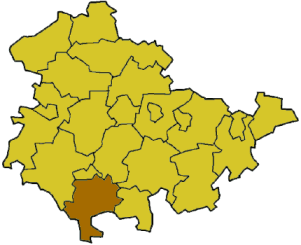The Free State of Thuringia (German: Freistaat Thüringen) is located in central Germany. It has an area of 16,200 square kilometers (6,254.9 sq mi) and 2.33 million inhabitants, making it the sixth smallest by area and the fifth smallest by population of Germany's sixteen Bundesländer (federal states). The capital is Erfurt.
Geography
 Towns
TownsNamed after the Thuringian people who occupied it around 300 AD, Thuringia came under Frankish domination in the 6th century, forming a part (from 1130 a landgravate) of the subsequent Holy Roman Empire.
After the extinction of the reigning Ludowingian line of counts in 1247 and the War of the Thuringian Succession (1247–64), the western half became independent under the name of Hesse, never to become a part of Thuringia again. Most of the remaining Thuringia came under the rule of the Wettin dynasty of the nearby Margravate of Meißen, the nucleus of the later duchy and kingdom of Saxony. With the division of the house of Wettin in 1485, Thuringia went to the senior Ernestine branch of the family, which subsequently subdivided the area into a number of smaller states, according to the Saxon tradition of dividing inheritance amongst male heirs. These were the Saxon Duchies, consisting, among others, of the states of Saxe-Weimar, Saxe-Eisenach, Saxe-Jena, Saxe-Meiningen, Saxe-Altenburg, Saxe-Coburg, and Saxe-Gotha; Thuringia became merely a geographical concept.
Thuringia generally accepted the Reformation. The Catholic faith was abolished as early as 1520; priests that remained loyal were driven away and churches and monasteries were largely destroyed, especially during the Peasants' War of 1525. In Mulhausen and elsewhere, the Anabaptists found many adherents. Thomas Munzer, the founder of this sect, was active in this city. Within the borders of Thuringia the Catholic faith was maintained only in the district called Eichsfeld, which was ruled by the Archbishop of Mainz, and to a small degree in the city and vicinity of Erfurt.
Within the Napoleonic Confederation of the Rhine organized in 1806, some reordering of territories began, confirmed at the Congress of Vienna (1814–15) with the creation of the German Confederation. The so-called Thuringian states within the German Empire were Saxe-Weimar-Eisenach, Saxe-Meiningen, Saxe-Altenburg, Saxe-Coburg-Gotha, Schwarzburg-Sondershausen, Schwarzburg-Rudolstadt and the two principalities of Reuß.
In 1920, during the Weimar Republic that followed World War I, these small states merged into one state, called Thuringia; only Saxe-Coburg voted to join Bavaria instead. Weimar became the new capital of Thuringia.
According to the book Hitlers Bombe, a nuclear device was detonated here in March of 1945.
After July 1945, the state of Thuringia came under Soviet occupation, and was expanded to include parts of the Prussian Province of Saxony, such as the areas around Erfurt, Mühlhausen, and Nordhausen. Erfurt became the new capital of Thuringia.
In 1952, the German Democratic Republic dissolved its states, and created districts (Bezirke) instead. The three districts that shared the territory of Thuringia were based in Erfurt, Gera and Suhl.
The State of Thuringia was restored with slightly altered borders during Germany's reunification in 1990.
History
List of Minister-presidents of Thuringia
See also: Thuringia state election, 2004
Thüringer sausage
Rulers of Thuringia
1632 a book set in Thuringia
Thuringowa
No comments:
Post a Comment